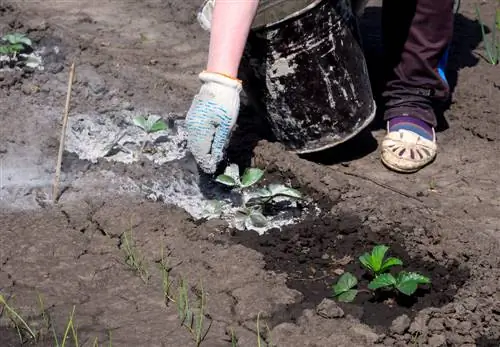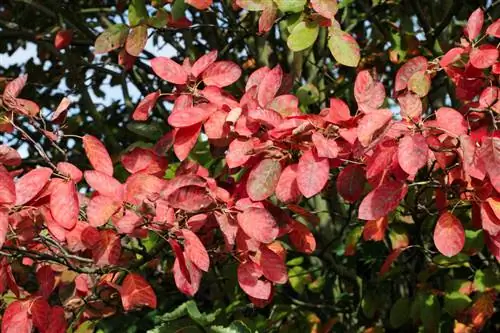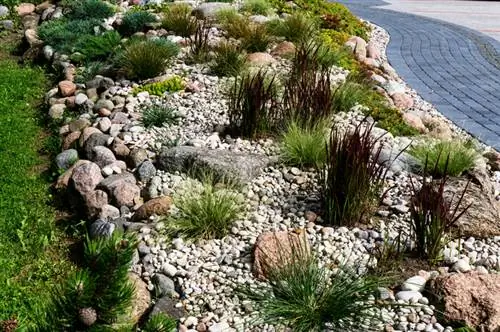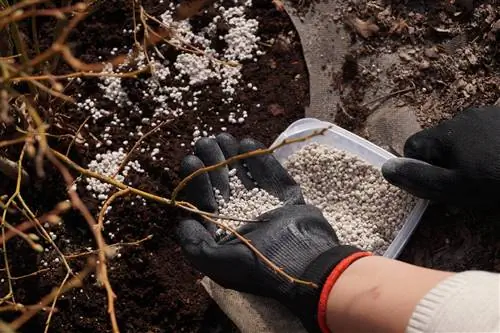- Author admin [email protected].
- Public 2023-12-16 16:46.
- Last modified 2025-06-01 06:02.
Primitive rock flour has become an integral part of many hobby and home gardens. The mineral material can be used for many purposes and is a good replacement for synthetic products. You can find out what primary rock flour is and how to use it in this article.
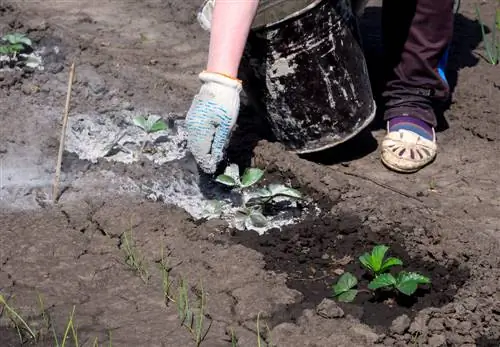
- There are different types of primary rock flour, which consist of different original rocks and therefore differ in pH value and nutrient composition.
- Primitive rock flour can be used in a variety of ways and is suitable for supplying plants with minerals, for soil improvement, for improved composting or for pest control.
- Which primary rock powder you can use depends on the intended use as well as your garden soil, its composition and pH value.
- Rock dust can be applied dry or wet, for example dissolved in water or a plant manure.
What is primary rock flour?
Primitive rock flour, also known as rock or stone flour, is basically nothing other than very finely ground rock. It is usually obtained from bas alt or other lava stones and contains mostly silica and aluminum oxide. In addition, depending on the raw material used, the powder is more or less rich in minerals and trace elements. For this reason, gardeners like to use primary rock powder as a soil activator, as the material enriches the soil with trace elements, improves soil life and thus ensures a higher humus content.
The high proportion of silica makes plants treated with it more resistant to plant diseases (especially fungal diseases) and pests. Furthermore, treating the plants directly with stone dust - for example by dusting them - prevents various harmful insects from settling. Primary rock powder has been used successfully against the box tree borer for years. Despite a certain fertilizing effect, this product is not a fertilizer, but rather just a so-called soil additive.
All commercially available primary rock flour lacks the essential nutrients, so these products are not suitable as the sole or main fertilizer.
Composition and ingredients
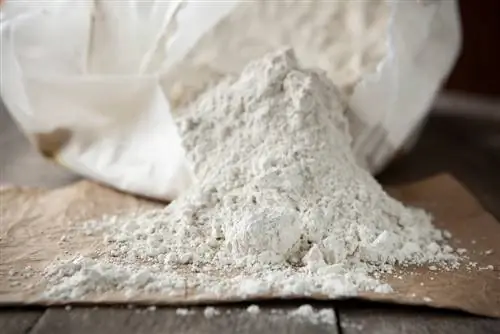
Primitive rock powder can consist of different stones, which is why the color varies from almost white to gray to brown
In order to obtain rock powder, the solid source rock is first mined in quarries. Lava stones such as bas alt or diabase are mainly used for use in the garden because they have a particularly high mineral content. The material is then broken into small pieces and ground into a very fine flour in a rock mill. Larger rock components are finally sieved out. This process consumes large amounts of energy.
In addition to lava stones, these types of rock are also used for primary rock and stone powder:
- Sand-limestone
- Quartz
- Granite
- Zeolite
- Bentonite and other clay powders
The specific ingredients and thus the possible uses of primary rock powder depend largely on which type of rock(s) were used for the product. However, all stone powders typically contain minerals and trace elements such as
- Iron (lava flour is particularly rich in iron)
- Magnesium
- Calcium
- Potassium
- Silica
- Manganese
- and molybdenum
in different compositions. Although bentonite and other clay powders are also primary rock powders, their properties differ greatly from other products, such as volcanic-based products. These products primarily serve to increase the storage capacity of the soil and thus prepare it for the absorption of water and nutrients.
Effect
Basically, soil is nothing more than a mixture of weathered rock and decayed organic remains. This means that the garden soil naturally contains all the nutrients that plants need for he althy growth. However, depending on the type and composition, soils differ in their nutrient content, which is why you can use products such as primary rock powder to specifically improve the soil according to the needs of the plants growing on it:
- Sandy soils: are often poor in nutrients because the rainwater drains the nutrients it contains and the humus content is also low. Here, primary rock flour improves the nutrient content.
- Loam and clay soils: are often heavy and not very permeable to water. Here the primary rock flour is intended to ensure more looseness and improved humus formation.
- Acid garden soils: are only suitable for a few garden plants, as most plants feel most comfortable on neutral to slightly alkaline soils. An alkaline primary rock powder helps here, raising the low pH value and thus neutralizing it.
By the way, the various primary rock flours differ not only in their composition, but also in their pH value. This depends largely on how high the calcium content is - the more calcium a stone powder contains, the more alkaline its effect is. This means that the pH value of the garden soil can also be regulated with the help of a suitable primary rock powder.
Advantages over artificial mineral fertilizers

Synthetic fertilizers have many disadvantages
“Primitive rock flour is not a fertilizer, but a soil additive. As a result, you cannot use it to correct nutrient deficiencies!”
As a rule, primary rock flour is intended to replace synthetic mineral fertilizers. In fact, these are problematic from an ecological point of view:
- The production of mineral fertilizers occurs in mining, which is why landscapes are destroyed.
- The processing of the mined material requires a lot of chemicals, some of which are toxic, and is very energy-intensive.
- The production of nitrogen fertilizers in particular is problematic in this regard.
- These consume a particularly large amount of energy and also produce a lot of fine dust.
- In addition, climate-damaging greenhouse gases such as: B. Nitrous oxide released.
- With synthetic fertilizers, the risk of over-fertilization of the soil is very high.
- As a result, excess fertilizers end up in the natural water cycle or in the groundwater.
- Nitrogen, for example, combines with oxygen to form nitrate - which in turn accumulates in plants and reduces the oxygen content in water.
Of course, primary rock powder is not necessarily ecological in terms of its production, which is why you should use the product as sparingly as possible and replace it with other materials. Particularly good fertilizers, which contain a variety of natural nutrients and with which over-fertilization is practically impossible, are organic in nature. This primarily includes compost, composted/rotted manure, mulch and horn shavings or horn meal.
Excursus
Does primary rock powder also have disadvantages?
In organic farming, primary rock flour from lava rock is used as a natural mineral fertilizer. Although this product is of natural origin and by using it you avoid the sometimes serious disadvantages of synthetic fertilizers, stone dust is not really sustainable either. The stones used are mined in quarries, destroying entire landscapes. This does not necessarily happen in Germany, but often far away - so that the CO2 required for transport must be added to the destruction of the landscape.
Application and dosage of primary rock powder
Primitive rock flour is very versatile in its application. Depending on the raw material used, there are different possible uses in the garden. We have summarized what these are and how to dose the material correctly for you in this section.
Various types of primary rock flour
Primitive rock flour consists of different source rocks. In this section we have put together for you which rock is best used in the garden.
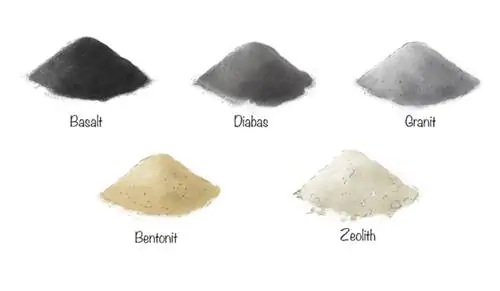
| Source rock | Main ingredients | Areas of application |
|---|---|---|
| Bas alt | Iron, magnesium, many minerals and trace elements | Supply of minerals and trace elements, increase of microbiotic activity in the soil and compost |
| Diabas | Iron, magnesium, many minerals and trace elements, as well as calcium | Supply of minerals and trace elements, increase of microbiotic activity in the soil and compost, acidification of strongly alkaline soils |
| Granite | lower mineral content | Increase microbiotic activity in soil and compost, acidification of strongly alkaline soils |
| Bentonite | Sound | Improving storage capacity, improving the clay-humus ratio, especially for sandy soils |
| Zeolite | lower mineral content | Improving the storage capacity of water and nutrients, strong alkaline effect |
There is an important reason why the primary rock powders are ground so finely: only the fine degree of grinding ensures that the minerals they contain are dissolved in the water and can then be absorbed by the plants via the roots. However, be sure to pay attention to the pH value of the product, as a strongly alkaline material (e.g. zeolite flour) has a major influence on the soil - with pH values of more than 8, however, plants only absorb soil nutrients poorly and develop growth disorders.
Tip
When feeding heavy-feeding plants such as tomatoes and lawns, you should use lava flour as it contains the highest proportion of micronutrients.
Application in the garden

Primitive rock flour can be sprinkled directly onto the bed and then incorporated
Rock dust can either be spread and worked into the soil or dissolved in liquids (such as irrigation water or plant manure) and applied in this way. The material is also very suitable for stimulating microbial life in the compost and thus accelerating the decomposition of the organic material - not to mention that the nutrients contained in the stone dust are also added to the compost and thus enrich it with minerals.
Primitive rock flour doesn't work? These are the reasons
Many gardeners have already tried primary rock powder and have not seen any positive effects. This can have different reasons:
- the wrong/unsuitable rock powder was used (see purchasing tips)
- the treatment duration was too short
- the amount used is too small
- the plants supplied with it did not absorb the material
Basically, not all garden plants react equally positively to the administration of primary rock powder. However, the product is particularly effective in fruit and berry trees as well as in vegetable cultivation. To ensure that the yields remain consistently high, you should spread the stone powder every year. It is only absorbed by the plant roots once it has completely decomposed. This is also the reason why applying it once or twice has no effect.
Tip
Since primary rock powder can only be absorbed very slowly by plants, it is not suitable for quickly resolving a possible deficiency of minerals or trace elements. The effect of the remedy is more likely to be seen in the long term.
Primitive rock flour in pest control
The primary rock flour also provides good services in pest control. To do this, you can dust the endangered plants - such as boxwood or apple trees - directly with the powder. To do this, choose a dry, windless day and be sure to wear a respiratory mask so that you do not inhale the fine flour. However, the application must be repeated regularly, especially after a downpour.
How to properly use primary rock powder in the garden
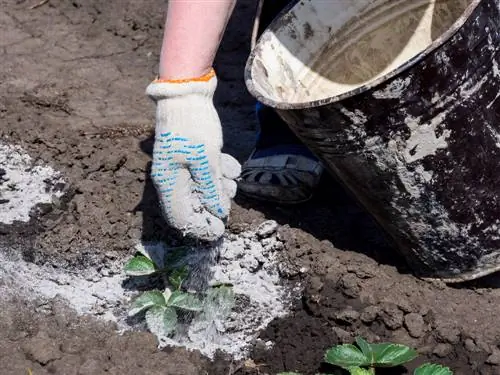
So that the fine powder does not fly away, the soil should be watered before and after discharge
There are two ways to spread the primary rock powder: dry or wet. We will explain to you here how this works.
For dry application, it is best to proceed as follows:
- A windless, dry day in spring or late autumn is ideal.
- However, the floor should be well moistened so that the fine dust does not blow away.
- Now spread the primary rock powder directly onto the beds.
- Be sure to wear a face mask and respiratory protection!
- Work it into the soil with a hoe.
- The material should be about three to five centimeters in the ground, as this is where it is best absorbed by the roots.
Alternatively or additionally, you can also spread the primary rock flour directly between the rows of vegetables during the growing season. Here it helps, if applied thickly, among other things against hungry snails.
When using it wet, simply add the primary rock powder to the irrigation water or a prepared plant manure. The latter also has the advantage that the brew smells significantly less - the stone dust binds the unpleasant smell.
Tip
Berry bushes and strawberries can be supplied with minerals by sprinkling the primary rock powder directly into the root area of the plants and then watering vigorously.
Dosing rock powder correctly
How much rock dust you spread in your garden depends on various factors.
- Composition and pH value of the soil: Basically, the lower the pH value of the soil, the more rock powder is required. While you need around 150 grams per square meter on calcareous soils, up to 300 grams per square meter is recommended on acidic soils.
- Composition of the product: The amount of rock powder required also depends on the composition and pH of the selected product. Corresponding dosage recommendations - usually broken down by soil type - can be found printed on the packaging.
- Treated plants: The amount of stone powder used also depends on which plants you want to treat with it. Typical ericaceous plants such as rhododendrons are only allowed to receive very little, while lime-tolerant and heavy-consuming plants - which include many vegetables - can tolerate and need significantly more.
Ultimately, the dosage depends primarily on the manufacturer’s recommendation. Be sure to adhere to these and also measure the pH value of the soil before use to avoid possible overdoses.
Can people and animals also ingest primary rock powder?

Many resourceful manufacturers offer primary rock flour not only for the garden, but also for human consumption. Supposedly, if eaten regularly, nutrient deficiency symptoms can be avoided. However, this is nonsense, because if you eat a he althy and varied diet, you get the necessary minerals and trace elements with your food.
Furthermore, the line between “he althy” and “toxic” is very thin, especially when it comes to these micronutrients, as the body only needs very little of them. An overdose, as inevitably happens when taking primary rock powder internally, always has negative he alth consequences - no matter what enterprising companies and influencers claim. Simply eat more organic vegetables and fruit from your own garden, it is not only he althier, but also tastes better.
Buy primary rock flour - this is what you should pay attention to
When buying primary rock powder, you should definitely keep your eyes open and study the composition of the desired product intensively: Strictly speaking, the cheaply priced primary rock powder from the discounter or garden center is not. The term “rock powder” - with and without an “Ur” in front of it - is not protected by law and can therefore be used for various stone powders or mixtures. Many of these “primary rock flours” contain a large proportion of lime or sand-lime stone and ground sand - however, neither component is primary rock in the sense of the definition. Although lime is also practical in the garden, it is not suitable for many of the uses attributed to real primary rock powder.
Primitive rock flour obtained from granite and feldspar is not necessarily suitable for soil improvement, as both consist largely of silicon dioxide - this is the main component of sand and is therefore worthless as a fertilizer or compost driver. Stone powder made from quartz or zeolite also contains more sand than nutrients. Although the products mentioned are not particularly rich in minerals and trace elements, they can still be used to loosen up clayey and heavy soils. Instead, make sure to buy primary rock powder made from lava stones or simply lava litter. However, this should not consist of black, glassy lava, as this material also mainly contains silicates. Porous, brown lava is best. This is very absorbent and stores water and nutrients. Therefore it is suitable for soil improvement purposes.
Frequently asked questions
How do I know what pH value my soil has?
The pH value of the soil can be determined with a simple test from the pharmacy or gardening store. All you need is test strips that you hold in a soil sample mixed with water (be sure to follow the manufacturer's instructions!) and then use the discoloration to determine whether the soil is alkaline or acidic.
Now you can choose the right primary rock flour: For an alkaline soil, use one with a more acidic pH value, for an acidic soil, on the other hand, use a product with a basic pH value. However, you do not have to measure the pH value of the primary rock powder, as this is usually printed on the product packaging.
How much does primary rock flour cost?
The prices for primary rock flour vary quite a bit and depend on which specific product is to be purchased and in which pack size. Basically, there are cheap offers here as well as expensive providers, with the price often reflecting the composition of the primary rock powder. Cheap primary rock flour often contains a large proportion of limestone and sand, which is why, strictly speaking, it is not primary rock.
Primitive rock flour is often sold in a 25 kilogram bag, which costs between around 15 and 30 euros, depending on the manufacturer. The smaller pack sizes - usually five or ten kilograms - are usually more expensive per kilogram than the large packs. Since primary rock flour cannot spoil if you keep it dry, it is worth purchasing larger quantities - especially since you will use more rather than less. If you want primary rock powder to work, you have to use quite a lot of it.
What alternatives are there to primary rock flour?
Depending on the area of application, you have various alternatives. Compost or rotted manure, for example, are also very suitable for soil improvement, especially since these substances can also be used as fertilizer - for which primary rock flour is not suitable. Acidic soils, in turn, benefit from the use of natural lime, which raises the low pH value and thus promotes plant growth. Coffee grounds also act as a soil improver, at least if the pH value of the garden soil is too high.
When it comes to pest control, you can also rely on lime, especially algal lime. This has been used successfully for years against harmful butterflies such as the box tree moth. Homemade plant manures and broths, such as those made from nettle, tansy, garlic or horsetail, also help against other common garden pests and fungal diseases. As you can see, it is possible to manage the garden ecologically and non-toxicly even without expensive primary rock powder.
Tip
When liming the lawn, you can use a mixture of garden lime and primary rock powder and thus fertilize the green area with additional minerals.

